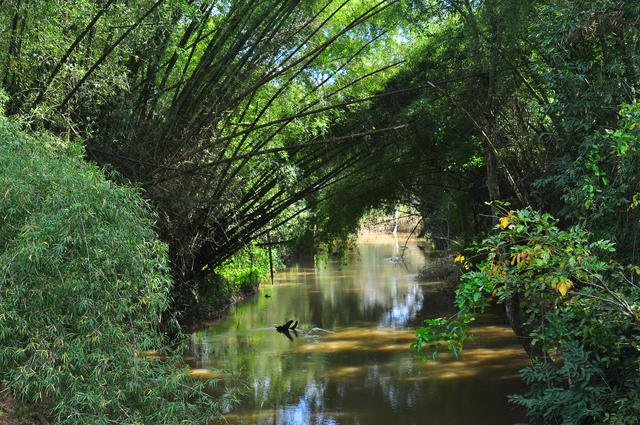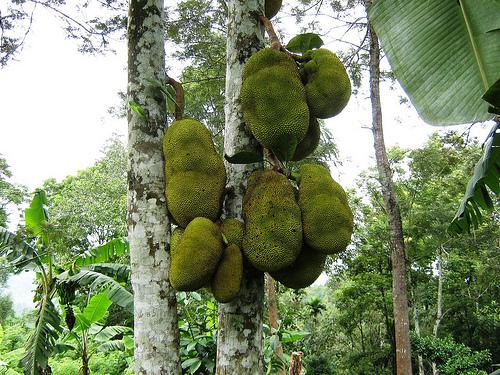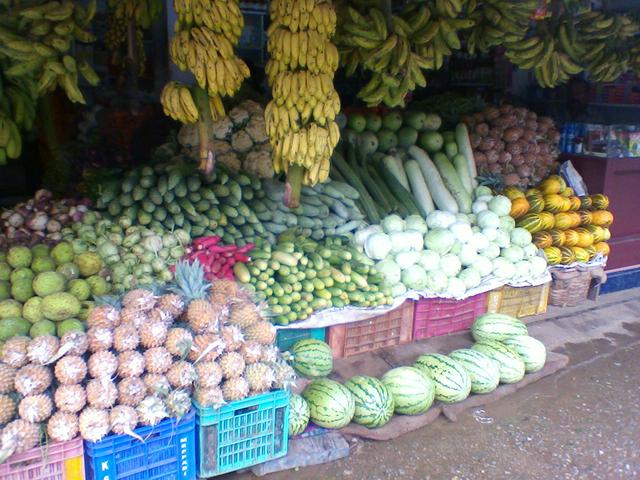Sultan Bathery, also spelled Sulthan Bathery and previously known as Sultan's Battery, is a town in the Malabar region of Kerala, India.


The town in olden days served as a military post of Tipu Sultan and the Sultan had a battery placed here, hence the name Sultan Battery. The town was previously called Hennaradu Peedike (Twelve Shops). The town is at an altitude of 930 meters. The place is famous for its Jain temple.
Sultan Bathery is almost exactly halfway between Mysore and Kozhikode.
- Assumption Church.
- Banasura Sagar Dam - It is the largest earthen dam in India and the second largest in Asia, and an ideal starting point for hikes into the surrounding scenic mountains.
- Bathery St. Mary's Orthodox Cathedral. The oldest Malankara Orthodox Christian settlement began in the 1915.
- Battery Jumaa masjid. This is the biggest jumaa masjid in the town and it can hold more than 1000 worshippers.
-JdLzh.medium.jpg)
- Edakkal Caves. 9AM to 4PM (last entry). This must-see location of breathtaking beauty in the Ambukuthy Mountain is not a cave in the real sense. As stated in the India Antiquary, it is only a cleft about 96 ft long and 22 ft wide in the rock. The word Edakkal (Eda+kal) itself means middle of the rock. It is a fissure made by a corner of rock splitting off from the main Entrance to Edakkal Caves due to some natural causes. The depth of the cleft and the fissure is 30 ft. What makes it a cave to the ordinary observer is the fact that in the other portion of the large cleft, an enormous rock, weighing several tonnes, has fallen forming a roof over a large part of it.
The rock wall contains some interesting carvings, which represent human and animal figures and objects of human use and symbols. These carvings, dating to the Neolithic age (6000 BC), speak of a highly civilized people of pre-historic age and inspires the archaeologists and historians to rewrite the history of Wayanad and Kerala as a whole. Specifically, look out for the carvings interpreted as the woman with the jug, the sun, the chieftain, the animal, and the peacock. The caves were discovered in 1894 by an English police superintendent named Fred Fawcett. The story goes that he discovered a hunting axe, which eventually led to the discovery of the caves. However, the caves were taken over by Archeological Survey of India only in 1984, so some vandalism can also be spotted on the walls. A vertical cleft near one of the corners offers a rare view of Wayanad.
These caves are said to have been frequented by Jain monks at a later age. The guard at the caves may be ready to help out with information. The caves are accessible now with steep but strong steps. There are excellent views of Wayanad on the way up, and there are a separate set of steps leading down as a faster route ₹30. - Ganapati Temple. The major Hindu place of worship.
- Jain Temple. The temple is believed to be built in the 13th century was a place of commerce and worship until Tipu Sultan made it his military hangout where he placed a battery and hence the name Sultan Battery. Also known as Tippu's Fort.
- Kanthapara Waterfalls. A 30 m high waterfall.
- Kuruva Dweep, +91 4936 203428. 950 acres of ever green forest on the tributaries of east flowing river Kabini, is an ideal picnic spot, far away from the disturbances of city life. The island is uninhabited. Rare species of birds, orchids and herbs are the sovereigns of this supernal kingdom. As a precaution do not stay on this island after dusk. The island is sometimes closed for entry depending on whether the water level is dangerously close to flooding. Hence, in rainy season it is best to call up the authorities beforehand to enquire whether it is open.
- Mariyamman Temple. Patronised by the local tribes.
- Masjid Madeena. Juma Masjid in town.
- Pakshipathalam. It is a bird sanctuary accessible only be trekking. To visit this place, special permission needs to be obtained from the forest department.
- Panaraman Jain Temple.
- Pazhassi Raja Tomb. Memorial of the Lion of Kerala Veera Pazhassi Raja, who organized a guerrilla warfare against the British East India Company.
- Thirunelly Temple. Often called Thekkan Kasi. It is believed that a bath in the holy water of Papanasini will wipe off all the sins. Apart from the temple, Thirunelly is a place of scenic beauty. Its Famous for its architecture, the shrine is shielded with 30 granite on the bank of Papanasini river. Pakshipathalam, an interesting trekking centre, is 7 km away from the temple.
- Tholpetty Wildlife Sanctury, Kerala 673 592 (20 km east of Mananthavady, +91 4935-250853. 6AM-8AM, 3PM-5:30PM. Tholpetty wildlife reserve forest is another UNESCO international biosphere reserve apart from Muthanga, part of Nilgiris reserve. Two entry batches are permitted.
- Ponkuzhi Temple, Via Naikkatty on Gundalpet road.
- Lakshmi Narasimha Temple, Opposite Karuna Hospital, Kozhikode Road..
Assumption Church.
Banasura Sagar Dam - It is the largest earthen dam in India and the second largest in Asia, and an ideal starting point for hikes into the surrounding scenic mountains.
Bathery St. Mary's Orthodox Cathedral. The oldest Malankara Orthodox Christian settlement began in the 1915.
Battery Jumaa masjid. This is the biggest jumaa masjid in the town and it can hold more than 1000 worshippers.
Edakkal Caves. 9AM to 4PM (last entry). This must-see location of breathtaking beauty in the Ambukuthy Mountain is not a cave in the real sense. As stated in the India Antiquary, it is only a cleft about 96 ft long and 22 ft wide in the rock. The word Edakkal (Eda+kal) itself means middle of the rock. It is a fissure made by a corner of rock splitting off from the main Entrance to Edakkal Caves due to some natural causes. The depth of the cleft and the fissure is 30 ft. What makes it a cave to the ordinary observer is the fact that in the other portion of the large cleft, an enormous rock, weighing several tonnes, has fallen forming a roof over a large part of it.
The rock wall contains some interesting carvings, which represent human and animal figures and objects of human use and symbols. These carvings, dating to the Neolithic age (6000 BC), speak of a highly civilized people of pre-historic age and inspires the archaeologists and historians to rewrite the history of Wayanad and Kerala as a whole. Specifically, look out for the carvings interpreted as the woman with the jug, the sun, the chieftain, the animal, and the peacock. The caves were discovered in 1894 by an English police superintendent named Fred Fawcett. The story goes that he discovered a hunting axe, which eventually led to the discovery of the caves. However, the caves were taken over by Archeological Survey of India only in 1984, so some vandalism can also be spotted on the walls. A vertical cleft near one of the corners offers a rare view of Wayanad.
These caves are said to have been frequented by Jain monks at a later age. The guard at the caves may be ready to help out with information. The caves are accessible now with steep but strong steps. There are excellent views of Wayanad on the way up, and there are a separate set of steps leading down as a faster route ₹30.
Ganapati Temple. The major Hindu place of worship.
Jain Temple. The temple is believed to be built in the 13th century was a place of commerce and worship until Tipu Sultan made it his military hangout where he placed a battery and hence the name Sultan Battery. Also known as Tippu's Fort.
Kanthapara Waterfalls. A 30 m high waterfall.
Kuruva Dweep, +91 4936 203428. 950 acres of ever green forest on the tributaries of east flowing river Kabini, is an ideal picnic spot, far away from the disturbances of city life. The island is uninhabited. Rare species of birds, orchids and herbs are the sovereigns of this supernal kingdom. As a precaution do not stay on this island after dusk. The island is sometimes closed for entry depending on whether the water level is dangerously close to flooding. Hence, in rainy season it is best to call up the authorities beforehand to enquire whether it is open.
Mariyamman Temple. Patronised by the local tribes.
Masjid Madeena. Juma Masjid in town.
Pakshipathalam. It is a bird sanctuary accessible only be trekking. To visit this place, special permission needs to be obtained from the forest department.
Panaraman Jain Temple.
Pazhassi Raja Tomb. Memorial of the Lion of Kerala Veera Pazhassi Raja, who organized a guerrilla warfare against the British East India Company.
Thirunelly Temple. Often called Thekkan Kasi. It is believed that a bath in the holy water of Papanasini will wipe off all the sins. Apart from the temple, Thirunelly is a place of scenic beauty. Its Famous for its architecture, the shrine is shielded with 30 granite on the bank of Papanasini river. Pakshipathalam, an interesting trekking centre, is 7 km away from the temple.
Tholpetty Wildlife Sanctury, Kerala 673 592 (20 km east of Mananthavady, +91 4935-250853. 6AM-8AM, 3PM-5:30PM. Tholpetty wildlife reserve forest is another UNESCO international biosphere reserve apart from Muthanga, part of Nilgiris reserve. Two entry batches are permitted.
Ponkuzhi Temple, Via Naikkatty on Gundalpet road.
Lakshmi Narasimha Temple, Opposite Karuna Hospital, Kozhikode Road..
- Walk up Edakkal caves and Ambukuthi Mala. These three caves are located at a height of 1,000 m (3,281 ft) on Ambukuthi mala near Ambalavayal. From Edakkal, you have to walk 1 km to reach Edakkal Caves. One can see the new stone age pictorial writings on the walls of these natural caves.
- Bus-tour through tea estates. KSRTC operates a low floor non-AC all Wayanad round trip from Sultan Bathery. The bus starts by 7AM from Sultan Bathery and goes by Chulliyod, Ambala Vayal, Vaduvanchal, Meppadi, WIMS Hospital, Chundale and reaches Vythiri. The return trip is through the highway via Kalpetta, Meenangadi and finally reaches back at Sultan Bathery.
- Thovarimala. One can go trekking 400 m to reach Thovarimala Ezhuthupara where one can see stone age pictorial writings on a rock.
- Pulpally Road. The road from Sultan Bathery to Pulpally town goes through the very middle of dense forest and tribal settlements. The road is dark even at noon, because of very good tree cover. Buses are available every one hour on this route.
Walk up Edakkal caves and Ambukuthi Mala. These three caves are located at a height of 1,000 m (3,281 ft) on Ambukuthi mala near Ambalavayal. From Edakkal, you have to walk 1 km to reach Edakkal Caves. One can see the new stone age pictorial writings on the walls of these natural caves.
Bus-tour through tea estates. KSRTC operates a low floor non-AC all Wayanad round trip from Sultan Bathery. The bus starts by 7AM from Sultan Bathery and goes by Chulliyod, Ambala Vayal, Vaduvanchal, Meppadi, WIMS Hospital, Chundale and reaches Vythiri. The return trip is through the highway via Kalpetta, Meenangadi and finally reaches back at Sultan Bathery.
Thovarimala. One can go trekking 400 m to reach Thovarimala Ezhuthupara where one can see stone age pictorial writings on a rock.
Pulpally Road. The road from Sultan Bathery to Pulpally town goes through the very middle of dense forest and tribal settlements. The road is dark even at noon, because of very good tree cover. Buses are available every one hour on this route.
 Kerala food is available in restaurants. European food is available in resorts and home stays only.
Kerala food is available in restaurants. European food is available in resorts and home stays only.
Bamboo rice (called Mulayari by locals) can be found in Wayanad. These are seeds of the Bamboo plant, richer in protein than rice and wheat, but tasting like rice. Bamboo rice payasam stalls can be spotted near Edakkal caves walkway. Bamboo is said to yield seeds after a long span, so it is said that harvesting bamboo rice is a 'once-in-a-lifetime' experience.
Home-made chocolates and local Wayanad tea and coffee are also sold in many places. Shops near Edakkal caves offer many options such as spiced versions.
- Bamboo Mess Restaurant Near private bus station signal Sulthan Bathery Delicious kappa biriyani 04936 220748
The place is known for spices, tea and condiments and for the local handicrafts.
- The eastern hills of Kerala are vulnerable to attacks from an Indian communist group called Maoists. Recently they attacked the ticket counter of Silent Valley National Park, Mukkali. As the Maoists are armed and dangerous, be careful when you trek in lonely areas.
- Leeches are common in the hills. Carry some table salt to dislodge the leeches.
- Monkeys can be a nuisance, especially at places like Lakkidi viewpoint. Be careful and keep your car windows closed, and food items hidden.
- Gudalur
- Kalpetta
- Kozhikode
- Mananthavady
- Meppadi
- Mysore
- Ooty
- Wayanad Wildlife Sanctuary – 16 km to the east, home to large population of elephants, and other wildlife, including some tigers
